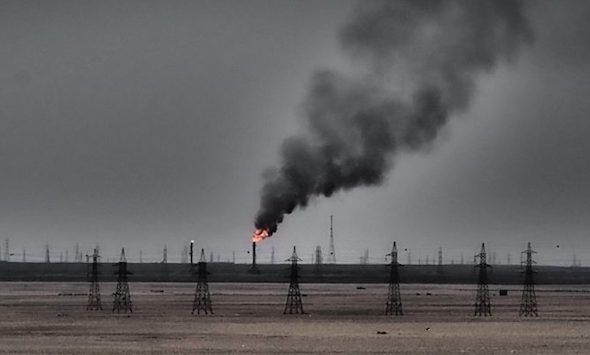Methane Emissions From Oil Production Are Higher Than Feared
A new study shows emissions up to twice as high as those estimated by "simplistic" data collection systems.
By Alex Kirby / Climate News Network

Oil fields release methane that must be recovered or flared to prevent leakage into the atmosphere. (wongaboo via Flickr)
LONDON — Global methane emissions from oil production between 1980 and 2012 were far higher than previously thought — in some cases, as much as double the amount previously estimated, according to a new scientific study
The reason for the discrepancy is simple. The author of the study — which also includes emissions of another gas, ethane — says it is the first to take into account different production management systems and geological conditions around the world.
Lena Höglund-Isaksson, senior research scholar at the International Institute for Applied Systems Analysis (IIASA) in Laxenburg, Austria, describes the old figures, which were based on arguing that what happened in North American oilfields applied equally to the rest of the world, as “rather simplistic”.
The IIASA study, published in Environmental Research Letters journal, is another reminder that climate science — like all science — is only as dependable as the data on which it relies.
In a system as complex as the atmosphere, faulty data can have far-reaching consequences.
Potent greenhouse gas
Methane is a potent greenhouse gas — the most important contributor to climate change after carbon dioxide. There is now international agreement that methane is 34 times more potent than CO2 over a century, but 84 times more over a much shorter timespan — just 20 years.
Yet while methane concentrations in the atmosphere can easily be measured, it is much harder to establish how much the different sources, whether human or natural, contribute to the total. This information is needed to work out how to reduce emissions.
Dr Höglund-Isaksson explains: “In an oil reservoir, there is a layer of gas above the oil that has a methane content of 50% to 85%. When you pump the oil to the surface, this associated gas will also escape.”
In oil production in North America, she says, almost all of this gas is recovered, and most of the small amount that is not will be flared to prevent leakage — and possible explosions. A very small amount is simply vented.
In other parts of the world, where gas recovery rates are lower, much larger quantities of methane emissions are released into the atmosphere.
“In an oil reservoir, there is a layer
of gas above the oil that has a methane
content of 50 percent to 85 percent.”
“Existing global bottom-up emission inventories of methane used rather simplistic approaches for estimating methane from oil production, merely taking the few direct measurements that exist from North American oil fields and scaling them with oil production worldwide,” says Dr Höglund-Isaksson.
(Bottom-up, in this context, involves multiplying the production of oil by the amount of methane released per unit of oil produced).
This approach left ample room for error, so she decided to find a new method to provide a better explanation for the global variations.
In the new study, Dr Höglund-Isaksson estimated global methane emissions from oil and gas systems in over 100 countries over a 32-year period, using country-specific data ranging from reported volumes of associated gas to satellite imagery that can show flaring.
She also used atmospheric measurements of ethane, a gas that is released along with methane and is easier to link more directly to oil and gas activities.
Dr Höglund-Isaksson found that global methane emissions, particularly in the 1980s, were as much as double previous estimates.
Russia’s methane emissions
The study also found that the Russian oil industry contributes a large amount to the methane emissions.
A decline in the Russian oil industry in the 1990s contributed to a global decline in emissions, which continued until the early 2000s. That was when methane recovery systems were becoming more common and also helping to reduce emissions.
But since 2005, emissions from oil and gas systems have remained fairly constant, which Dr Höglund-Isaksson says is probably linked to increasing shale gas production, which largely offsets emission reductions achieved through increased gas recovery.
She says that there is still uncertainty in the numbers, and that improving the data requires close collaboration between the scientific measurement community and the oil and gas industry to make more direct measurements available from different parts of the world.
The good news is that her research promises more accurate measurements of how much methane is in the atmosphere.
The less good news is that just how much is there appears to be increasing rapidly — faster than at any time this century.
Alex Kirby is a former BBC journalist and environment correspondent. He now works with universities, charities and international agencies to improve their media skills, and with journalists in the developing world keen to specialise in environmental reporting.
Your support matters…Independent journalism is under threat and overshadowed by heavily funded mainstream media.
You can help level the playing field. Become a member.
Your tax-deductible contribution keeps us digging beneath the headlines to give you thought-provoking, investigative reporting and analysis that unearths what's really happening- without compromise.
Give today to support our courageous, independent journalists.






You need to be a supporter to comment.
There are currently no responses to this article.
Be the first to respond.